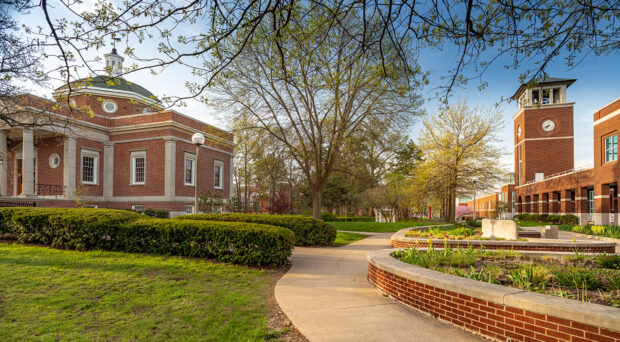HOME | ABOUT US | MEDIA KIT | CONTACT US | INQUIRE
HOME | ABOUT US | MEDIA KIT | CONTACT US | INQUIRE
A robust networK of public and private four-year universities, community colleges and trade schools helps keep the talent pipeline filled for employers.

PUBLISHED AUGUST 2023
For more than 318,000 college-age students and older, Missouri was exactly the right choice for education as the 2020-21 school year arrived.
That’s how many students flocked to more than 50 post-secondary campuses for their collegiate and certification studies. If past trends hold, those institutions will pump tens of thousands of freshly-minted graduates into the state’s workforce; last year, that student cohort combined to secure 92,383 diplomas or certifications.
The state has much riding on efforts to keep those graduates within its borders as they start their careers, and the implications for Missouri are profound: While the state does better at getting students through high school—89.9 percent finish 12th grade, vs. 88.0 percent nationally—the most recent Census data pegs the degree-holding share of Missouri’s population at 29.2 percent, compared to the national average of 32.1 percent.
So the state must double the share of the population that is degree-holding if it’s to meet the 60 percent target that former President Obama championed back in 2009 as his version of JFK’s “moon shot” national goal.
Clearly, though, the physical assets are in place to begin that process. Among the institutions of higher education within Missouri, you will find:
• The four-campus University of Missouri System, anchored by the main campus in Columbia, with regional campuses in Kansas City and St. Louis, and the science and technology-focused campus in Rolla. Combined, they had roughly 68,000 students enrolled last fall and issued nearly 18,500 degrees last year.
• Nine other four-year state-supported public colleges cover every corner of the land. The biggest of those, by far, is Missouri State University in Springfield, which had 23,502 enrolled last fall. Others include the University of Central Missouri in Warrensburg (9,959) and Southeast Missouri State University in Cape Girardeau (9,984), Northwest Missouri State University in Maryville (7,262 students), Missouri Southern State University in Joplin (5,036), Missouri Western in St. Joseph (4,902), and Truman State University in Kirksville (4,655).
• More than two dozen private liberal arts colleges combined enrolled nearly 106,000 students last fall. The crown jewel among those: Washington University in St. Louis, a world-recognized research university and an enrollment of nearly 15,500 last fall.
• And 14 community colleges—enrolling more than 75,000 students last fall—that fill a larger role in immediate workforce training, usually working in concert with employers to identify skills needed and emerging knowledge sets as business conditions change.
That doesn’t even touch on specialty and technical schools serving post-secondary students, or the 226 public school districts across the state with nearly 880,000 more students, or hundreds of small, private K-12 schools with thousands of additional enrollments.
On the post-secondary financing front, years of belt-tightening that had cut into public-university budgets eased this year. The General Assembly responded to Gov. Mike Parson’s call for additional resources at state-funded universities with a 7 percent overall increase in institutional funding, plus projects that include a new veterinary hospital and a research facility at the University of Missouri.